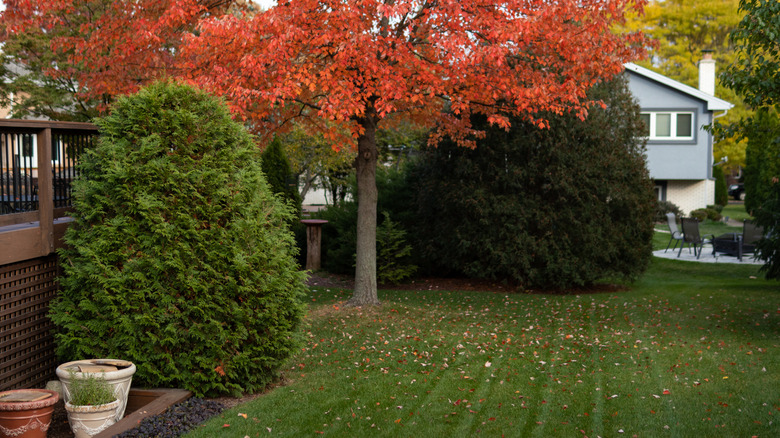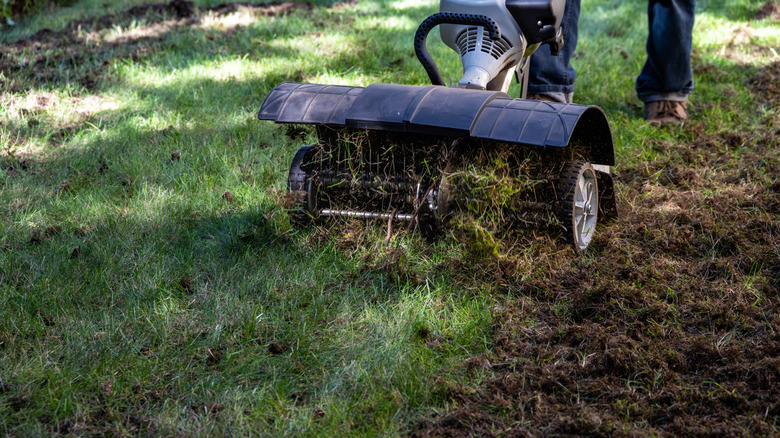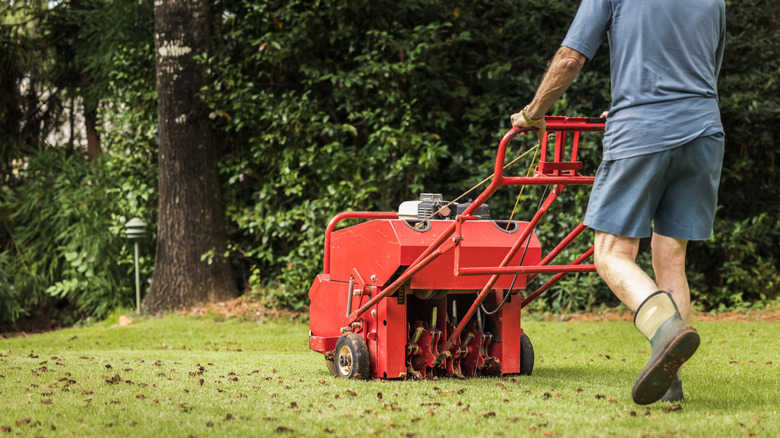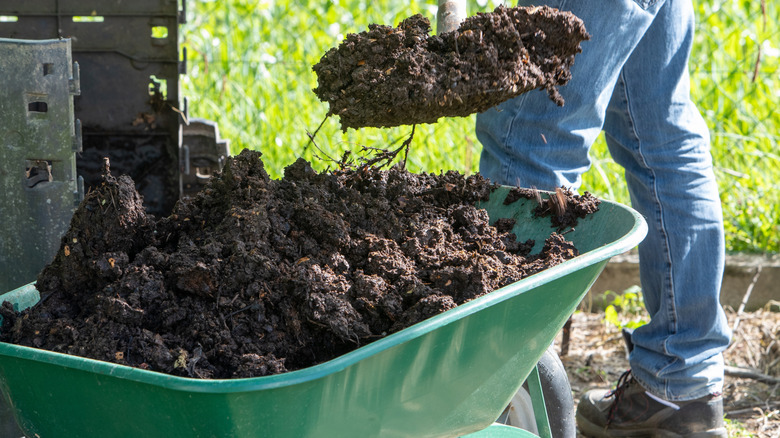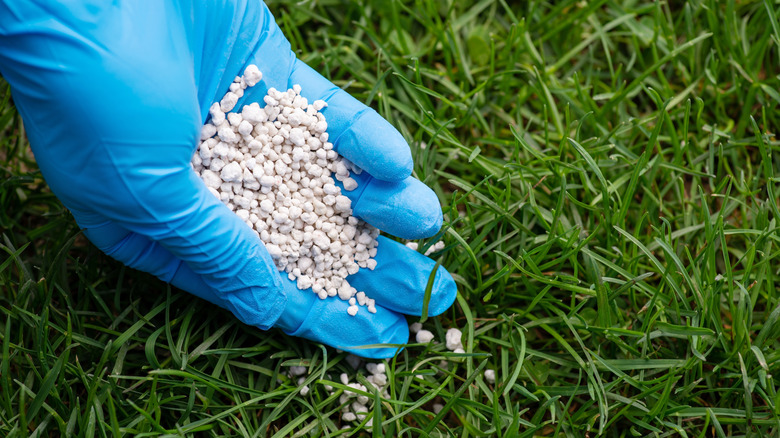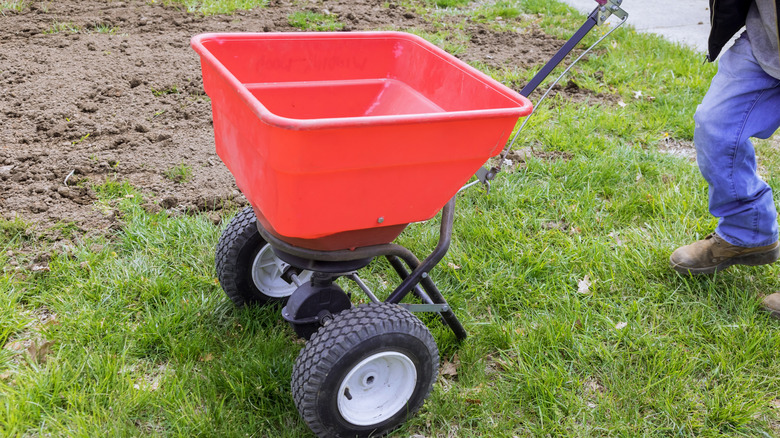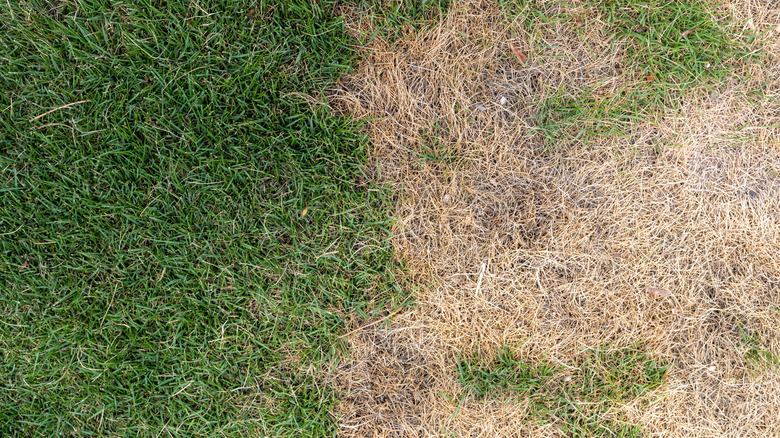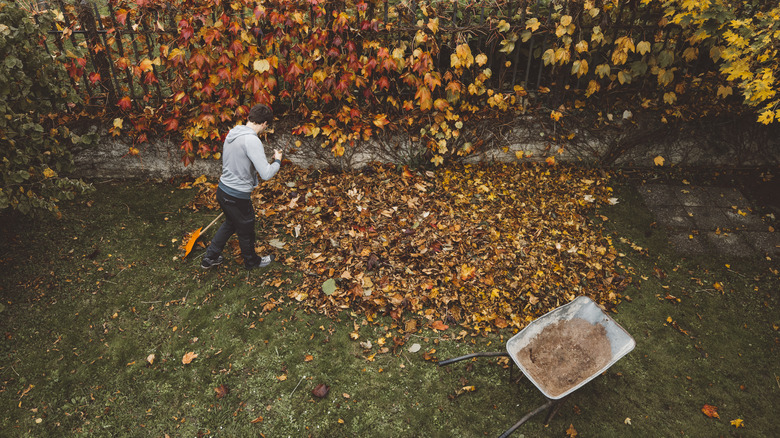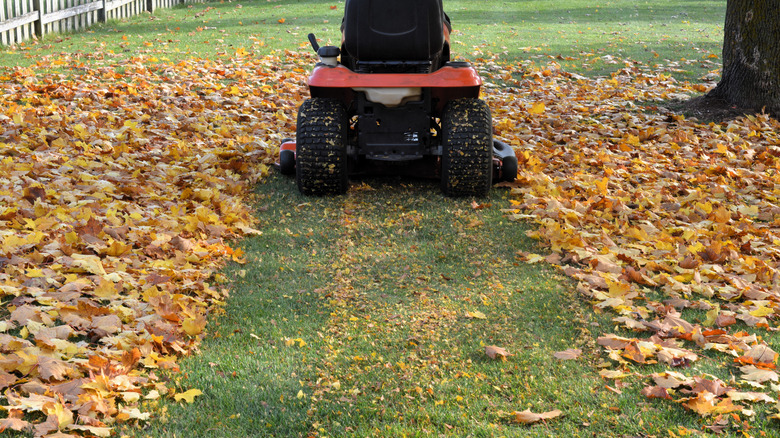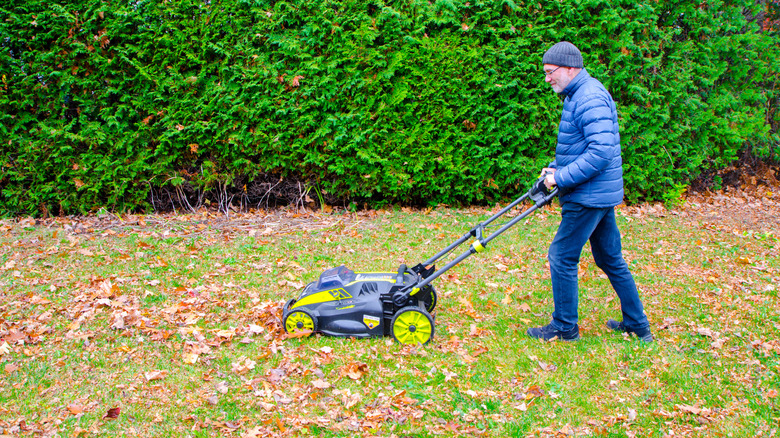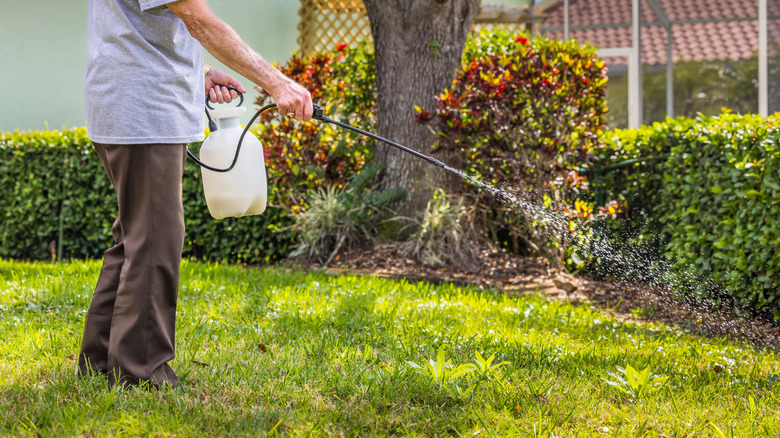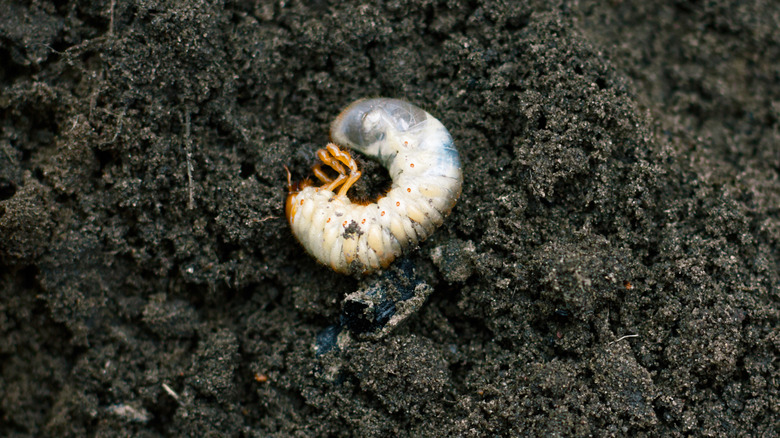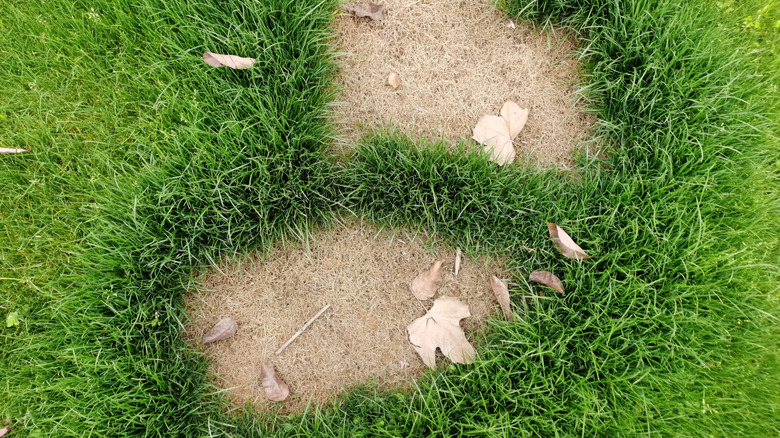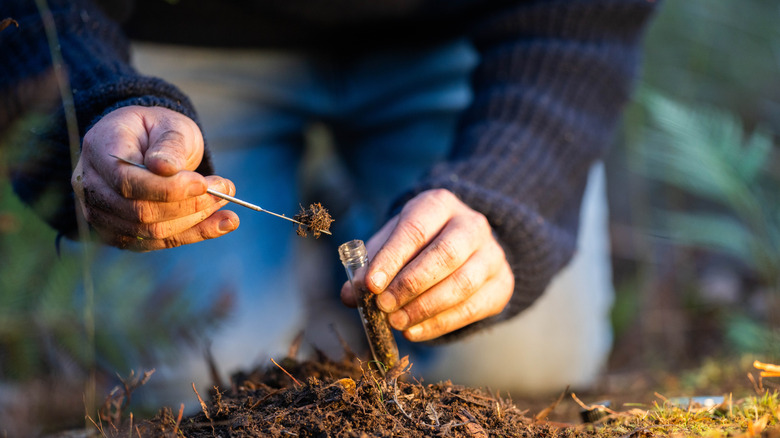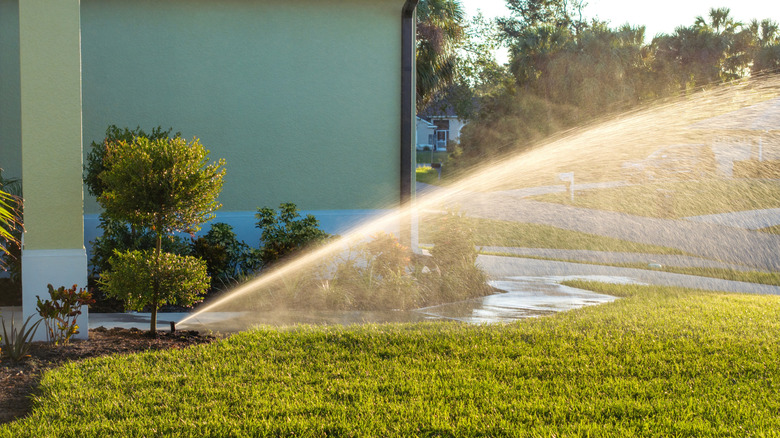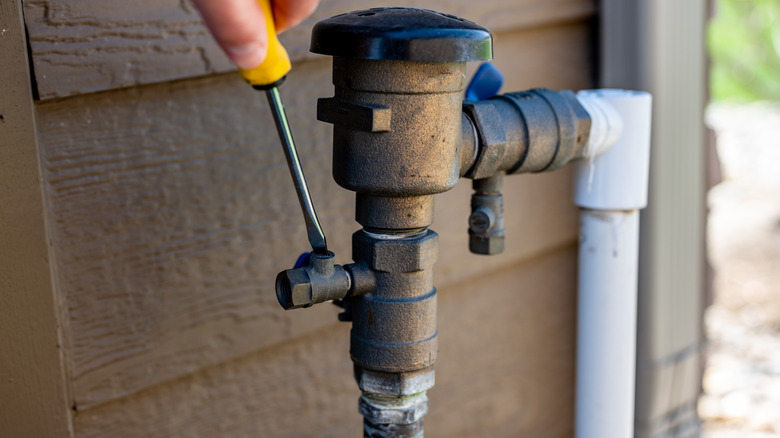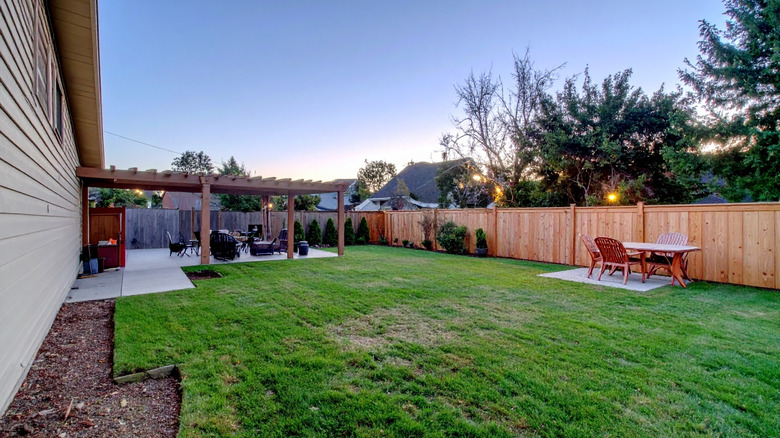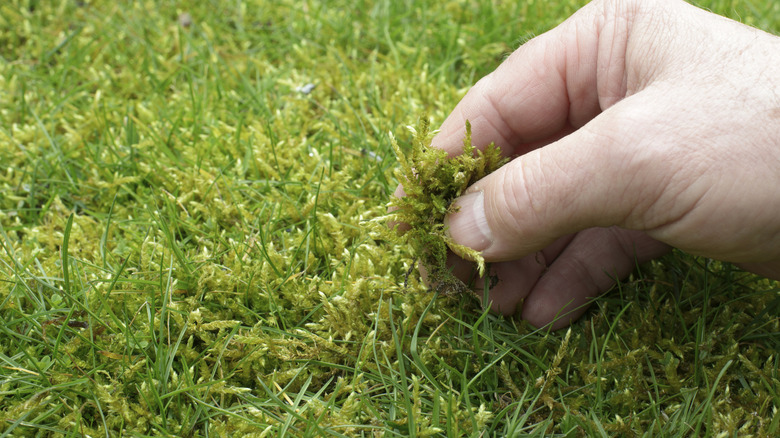17 Things To Do To Your Lawn Now Before The First Frost For More Success In The Spring
We may receive a commission on purchases made from links.
After spending all summer mowing, sometimes as often as every four to five days, you're ready for a break. But don't put those lawn tools away yet. As the temperatures cool, your lawn gradually moves toward dormancy. But before it rests for the winter, there are several tasks to do to set your grass up for a successful spring. The care you put into it in the fall impacts how healthy and strong it is when it starts to green up next year.
Many of the tasks help strengthen the roots of the grass, thicken your lawn, and eliminate issues that can kill it, including pests and diseases. High summer temps often cause stress to lawns, which affects the health of the grass. Following good fall practices to revive the grass before dormancy helps it grow better the following year. Common fall tasks that help include aerating, dethatching, fertilizing, overseeding, handling weeds, and mowing a little lower than normal.
Dethatch if needed to allow nutrients to reach the roots
Bits of grass, leaves, and other vegetation often decompose, but some of it sits at soil level on your lawn, forming thatch. It's protective in thin layers, but thicker thatch can keep the grass from receiving nutrients and increases pest and disease damage. This isn't a task you'll need to do every year — only when the thatch layer is too thick. Caring for the lawn properly can slow the development of thatch and even prevent the need to dethatch. It tends to build up faster if you give the lawn too much water or fertilizer.
You'll know when it's time to dethatch your lawn if the grass has more of a bounce to it than normal. Check the thatch depth, and dethatch if it's more than ½ inch. The best time to dethatch a lawn at the end of the growing season is in late summer or early fall. Dethatching is hard on your lawn, so it needs that remaining growing time to recover.
Aerate cool-season grass to reduce compaction and increase nutrient accessibility
If the soil is compacted and your grass isn't growing well, aerating the lawn could help. By easing the soil compaction, it gives the roots more room to grow and allows necessary nutrients and oxygen to reach the roots. Aerating in autumn is ideal if you have cool-season grass, but you'll typically want to aerate in summer for warm-season varieties. Aerating is typically combined with overseeding to increase the thickness of the lawn heading into winter.
Lawn aeration is another task that doesn't always need to be done yearly — it depends on the foot traffic and soil type. Some heavily used lawns may need to be aerated every year or every other year. Average lawns only need it about once every two to four years. Core aeration is the best option as it removes plugs of soil, unlike spike aerators, which compact soil even more as they make holes in the ground.
Topdress the lawn to increase organic matter
When you topdress your lawn, you apply soil or compost over top of the grass. The goal is to add a thin layer of nutrient-rich organic material, not to smother the grass. The extra soil can help fix a nutrient imbalance, level the ground, and cut down on the need for fertilizer. Topdressing can help your fall overseeding be more successful since your seeds have direct contact with soil. You can use this method for your entire lawn or just on the areas that are thin and need a boost of grass growth.
If you're dethatching and aerating, wait to topdress the lawn until both of those steps are done. It's easier to disperse the soil with a compost spreading tool, like this Vevor Compost Spreader. However, you can also spread it with a shovel and rake it to ensure the yard has a layer between ⅛ and ½ inch deep, depending on the type of grass.
Fertilize to help grass recover from summer stress and strengthen roots
Fall is the best time of year to fertilize your lawn because it helps strengthen the roots when done correctly. Cool-season grasses, in particular, benefit from fall fertilization to support food storage and root development going into the colder season. September is an ideal application time if your goal is to thicken the grass and strengthen roots before winter, but November is also an option with that application helping the grass turn green faster in the spring.
A fertilizer with controlled-release nitrogen, such as coated urea or ureaform, is ideal for fall applications. Fast-release nitrogen products could cause too much green growth above the ground, sacrificing essential root development. Before applying fertilizer, check the regulations in your area. For example, in Maryland, you're not allowed to apply fertilizer after November 15 in the fall. Many states, including Maryland and Michigan, restrict you from adding phosphorus fertilizer to established lawns unless there's a deficiency indicated by a soil test.
Overseed to create a thicker lawn
Fall is the best time of year to reseed your lawn, especially if you have cool-season grass. Ideally, you'll want to seed between mid-August and mid-September. That way, the seeds germinate while the soil is still warm from summer, and they have cooler nights in the fall to help them grow quickly. If you miss the window for fall germination, consider dormant seeding, which is possible from November through March. Essentially, you're prepping the ground for early spring germination since the seeds won't germinate until the weather warms. It helps you get a jump start and avoids spring planting delays due to rainy weather.
When overseeding, make sure the grass is only 1½ to 2 inches high to improve how much contact the seeds have with the soil. Use a drop seeder or slit seeder to disperse the seeds, then water the area thoroughly, even if you're dormant seeding the lawn.
Address larger bare patches of lawn by hand or with sod
Early fall is a good time to address larger bare spots specifically. The cooler temperatures of fall help cool-season grass seeds grow well, and fall often has more rain to provide moisture. Using sod on bare patches gives you a quick solution for filling in those areas. You can lay sod at any time of the year, as long as the ground isn't frozen yet, which makes it a good option throughout the fall season if you missed the window for seeding.
Prep the bare spots well by raking — it's essential to make sure you get good contact with the soil. Blend a small amount of compost or topsoil with the seed to help it spread evenly, but keep the seed near the surface — no more than ¼ inch deep. Apply the mixture by hand to ensure you get firm contact with the ground. To sod, cut out the area and place a piece of sod that fits perfectly into the prepared section.
Remove fall leaves for nutrient and sunlight availability
As tempting as it is to ignore the mass of leaves in your yard, it's not healthy for your grass to leave the lawn buried. In the fall, the turfgrass needs ample sunlight and water or the food production and storage that will get it through the winter. For a lightly covered yard (about 20% covered with leaves), you may be fine simply leaving the leaves to decompose on their own. As it gets closer to 50% coverage, you need to take action.
Remove leaves in areas where most of the grass is covered. Raking and leaf blowing are two common methods for removing the leaves if you don't want to mulch them into the grass. If you have a compost bin, consider collecting the leaves and adding them to it — fall leaves serve as brown material in the bin and should be layered with green materials.
Mulch mow leaves back into your lawn
Another option for dealing with the leaves is mulching them back into your lawn. The organic material puts nutrients back into your grass as it breaks down. You don't want to leave them whole, though. They can smother the grass and encourage disease development if the grass is covered. Mulching the leaves with your mower breaks them down into smaller pieces, which means by spring you can work the matter into the soil or plant grass seeds into it.
To mulch leaves right into the lawn, go over them with your mower. Mulch the leaves frequently to keep up with them, especially if large amounts are falling every day. When you're done mulching, you should still be able to see 80 to 90% of the grass. Leaving more leaf debris on the grass could smother your lawn. Extra leaves can go into your compost bin.
Mow the lawn to a lower height until it stops growing
The best time of year to stop mowing your lawn is when it's no longer actively growing — usually October or November, but that will vary based on your climate. While you'll continue mowing until the grass stops growing, you'll need to change your mowing habits. In particular, it's best to gradually decrease the cutting height slightly. Ending the mowing season at a lower height helps reduce the risk of common fungi, like snow mold, which can happen when taller grass gets matted down under snow.
As you lower your mowing height, make sure the most you cut off each time is ⅓ of the blade length. More significant cuts can stress the grass and put it at risk in winter. The final mowing height before winter doesn't have to be significantly lower — about ½ inch (or one or two notches on your mower) should be sufficient. Avoid mowing the grass lower than 2 inches going into winter.
Deal with the weeds to start fresh in the fall
If you don't pull weeds this fall, you'll likely be dealing with a massive weed infiltration in the spring. Targeting weeds in the fall is often very effective because of how the plants prepare for winter — the weeds will take herbicides into their roots readily as they try to absorb nutrients in preparation for winter. It's also easy to spot the weedy areas in the fall as they tend to start growing well in the cooler temps.
Applying a preemergent herbicide in early fall helps stop winter annual weeds before they sprout, reducing weed pressure and competition for nutrients as your lawn prepares for dormancy.. Broadleaf weed control is also an option if you have fall weeds growing — they'll typically work into November to help you tackle those late-season weeds. Or, dig up the unwanted growth using a weeding tool. Pulling the weeds by hand can be effective if you have a relatively small weed problem.
Check for pests to keep them from overwintering
Plant growth might be slowing down in the fall, but that doesn't mean pests that can destroy your yard are gone. Grubs, armyworms, and other lawn-destroying pests are still active in the fall, which is why it's the ideal time to deal with them. If you don't deal with them now, they could cause even more issues in the spring. Many of the pests, like grubs, feed on the roots of grass, and since they're mainly underground, you might not notice them. But you will notice the damage they cause, usually in September and October, including discoloration, wilting, and dieback in irregular spots.
Since damage is often localized, you may be able to apply insecticide only where the insects are causing problems. Another option to control grubs is with parasitic nematodes, which are little roundworms that kill the grubs and several other insects. The nematodes work best before fall temperatures get too cold — the soil need to be at least 50 degrees Fahrenheit for them to remain active.
Treat lawn diseases to minimize damage
Fungal diseases often strike in the fall because of the cool, moist conditions that allow fungi to take hold. Applying heavy applications of nitrogen fertilizer in the fall can also encourage disease growth. By monitoring the lawn conditions, taking preventative steps, and treating signs of lawn disease, you're keeping the grass healthier as it goes dormant. That can set it up for success in the spring for disease-free growth as the weather warms.
Practicing good lawn care can help prevent and overcome disease issues. Avoid overfertilizing your grass in the fall, and balance how much irrigation you provide with the natural rainfall to avoid overly wet conditions. Applying fungicide in the fall can also help if the disease has taken hold. The specific application can vary based on the disease. Large patch fungus often responds well to an October fungicide application with a follow-up dose two to four weeks later, for example.
Test the soil and make amendments as needed
Testing your soil in the fall helps you identify nutrient deficiencies that could interfere with healthy spring grass growth. The pH is an important detail to test, as well — ideally, it should be between 6.0 and 7.0 for healthy plant growth. Making soil amendments based on test results in fall gives them time to change the soil and make a difference in your lawn. For example, lime typically needs at least three months to change the soil pH, so adding lime in the fall means the soil will be better by spring. The results can also help you choose the ideal fall fertilizer type to make up for deficiencies in the soil.
Based on the test results, add lime to your lawn if the results show acidic soil, or add sulfur to correct alkaline soil. In addition to pH, it's also common for soil tests to show phosphorus, calcium, potassium, and magnesium levels. Amend the soil based on any identified deficiencies. You can often get help from the local extension office in your area.
Change your watering routine until the first hard freeze
One of the mistakes to avoid when maintaining your yard this fall is forgetting to irrigate the grass. Despite the falling temperatures, your grass still needs moisture clear up until it goes dormant. It helps the grass survive the winter and pop up better in the spring. Letting your grass go without adequate water in the fall can make normal winter stress even worse. Irrigation is also good for fall fertilizer applications and overseeding. However, you don't need to irrigate at the same levels as summer, as too much moisture can contribute to disease and weed issues.
Fall lawns usually only need about 1 inch of water per week. Before turning on the sprinkler, remember that includes rainfall, which often increases in the fall. Instead of leaving your sprinkler system on the same schedule, adjust it to match the lower fall watering needs. Watering should continue until your area has its first hard freeze; then you can stop irrigating for the winter.
Winterize your sprinkler system to prevent damage
Winterizing your irrigation lines is the crucial fall lawn care task you might be forgetting about that goes along with the changes in your irrigation habits. The winterization process mainly involves making sure all water is drained from the system. Any water left in the pipes could freeze and cause significant damage to the pipes, valves, nozzles, and other components. The result is a hefty repair bill come spring.
Make sure you know how your irrigation system works and the best way to drain it since they can vary. Start by turning off the water supply to the system. Open each valve to let the water drain out if you're manually draining the system. Keep in mind that the pipes can shift or there could be issues with the installation that keep all water from draining, which leaves your system at risk of damage. Hiring a professional to blow the water out of your lines is an effective option that helps clear all of the water out.
Cut back on foot traffic to prevent damage
Summer tends to be a time of heavy foot traffic in yards. Add in the heat and lack of water, and you end up with a highly stressed lawn. Repeated footsteps across the grass, especially when it's dormant or already damaged, can make it weaker. We already know that fall is an ideal time to repair that damage from the harsh summer months, but many of the tasks are more effective if you limit foot traffic. Limiting foot traffic after overseeding protects the germinating seeds, for example.
Remind family members to avoid areas where you've recently put down new grass seed — put up a sign as a reminder if you need to. If you have pets or kids who still want to play in the yard, try rotating where they spend their time. Set up their toys in the front lawn instead of the back, or give your yard a break completely by walking to a nearby park or field for play time occasionally.
Address areas where moss has taken over
Noticing more moss than grass? The good news is, you don't have to worry that the moss is going to hurt your grass. But it is an indicator that you have some lawn issues you need to address. Moss takes hold in areas where grass doesn't grow well. This problem tends to happen if your area stays consistently moist — too moist for grass to take hold. Lack of sunlight and compact soil can contribute to moss growth. Dealing with those issues in the fall helps create better growing conditions for spring, so your grass can come in stronger.
Start by raking out the existing moss. You may need to amend the soil based on testing results or aerate to reduce compaction and minimize drainage issues. Pruning lower branches in areas with deep shade helps the grass receive more sunlight, which helps improve growth. Improved grading or drainage solutions are also options if the area remains waterlogged.
